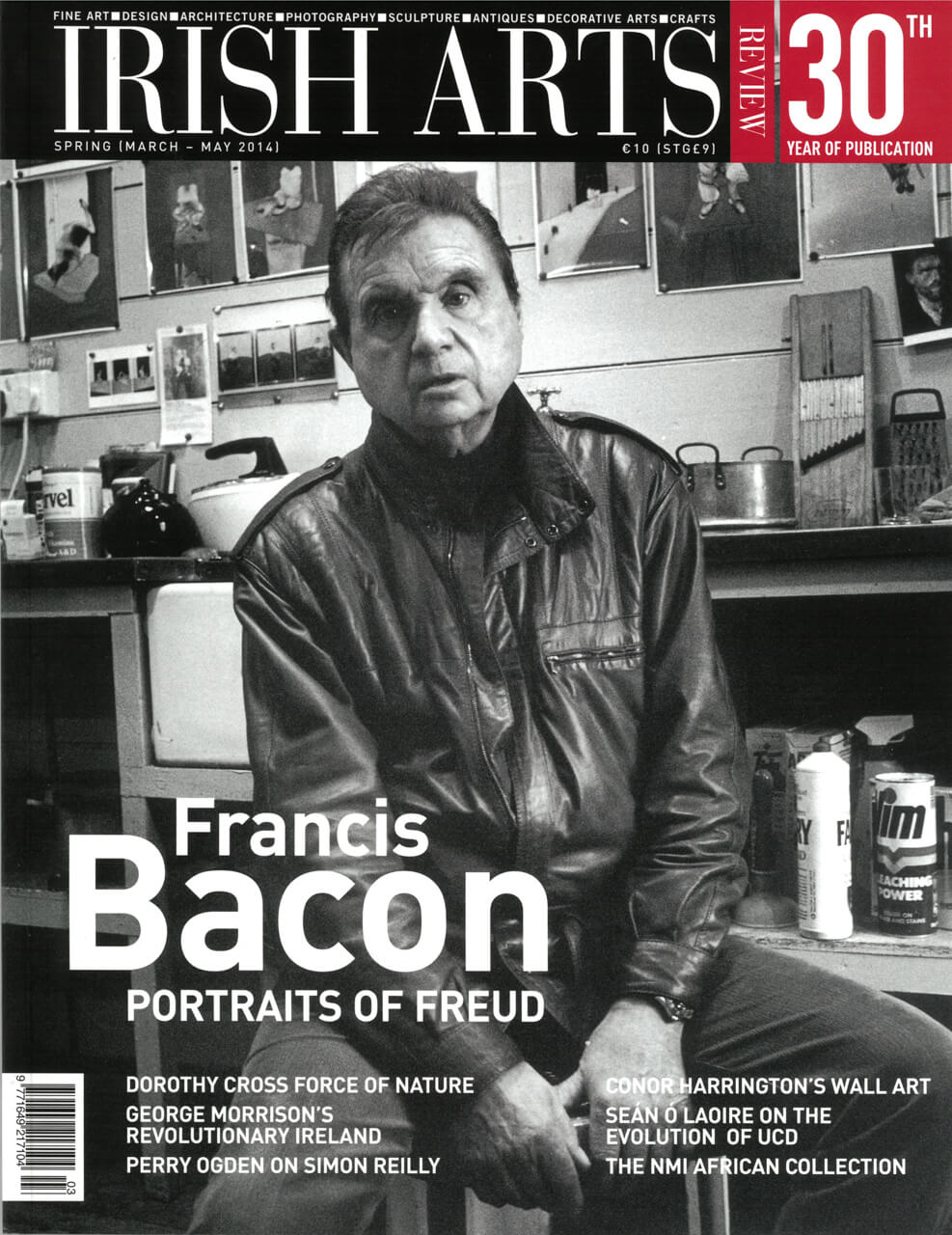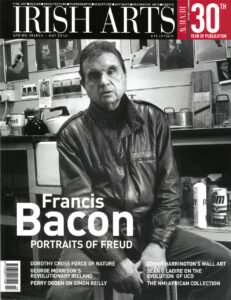

LA-based artist and filmmaker Simon Reilly tells Perry Ogden ‘Painting is always there with me, it’s my default, and then I’ll make a video and that enhances my painting’
I first met Simon in 1994. He was living and working in a single room in a derelict Georgian house on Henrietta Street in Dublin’s north inner city. I was immediately drawn to his paintings – the textures, the layers, the bitumen, the collage, the mysterious volcanic-like holes. They were abstract for sure. But I felt there was something else there. I wanted to peel away the layers, look beyond the horizon line. The texture, the paint and the way it was applied, all reminded me of Anselm Keifer but the paintings also felt unique, individual. Not as cold as Kiefer and his fellow German Expressionists. Equally dark and uncertain, yes, but here there was a warmth. And they seemed deeply personal. I wanted to know more.
Having left school in 1978 Simon enrolled in a Foundation Year at the College of Marketing and Design, Parnell Square, Dublin. He immersed himself in colour theory and life drawing classes and remembers a tutor who would bring in her young children and make them skip for the class, so the students could try to capture the movement. At the end of the year Simon knew he wanted to paint but didn’t want to take the obvious route of going on to NCAD. While he considered his future he visited a friend in Belfast. There he was given a tour of the College of Art and immediately offered a place on the fine art course. He found Belfast bizarre and stimulating and jumped at the opportunity. ‘The energy I felt there was amazing, there was so much music, performance art and film work, that’s when I first started playing around with film. But everything was totally imbued with the politics of Northern Ireland. You couldn’t escape it.’
Simon had grown up in middle-class Dublin, almost oblivious to the Troubles, but now he found himself in the thick of it. One night on his way home in the early hours he came upon a UVF bombing. ‘I reached my block and saw an RUC jeep parked in the road. As I crossed the street there was an almighty explosion and the RUC jeep was thrown in the air and flipped over. All I remember was hearing a scream and then seeing this man who looked like he was sitting in a hole in the road, but as I got closer I saw that he wasn’t sitting in a hole – his legs had been blown off.’ In 1982 Simon took a year out from college and went to New York to work as an apprentice to Sandro Chia, the much-feted Italian who was a central figure in the Transavantgarde (neo-expressionist) movement, which included Francesco Clemente and Enzo Cucchi. But it didn’t pan out the way Simon had hoped: ‘I was enamoured by the New York neo-expressionists and I loved Cucchi and Paladino and the way they were using figures and colour. But when I got to New York I found Chia doing designs for kitchenware and I was kind of appalled. I said this is not for me and left.’ He ended up on the Lower East Side, decided he was a guitarist, joined a band and played gigs at Danceteria and the Mudd Club. ‘I wasted a lot of time there. But it was fun. It was an amazing place to be in the early 1980s.’
The energy I felt there was amazing, there was so much music, performance art and film work, that’s when I first started playing around with film. But everything was totally imbued with the politics of Northern Ireland. You couldn’t escape it.’
Arriving back in Belfast eighteen months later to finish his degree course, Simon was given a studio in the Cathedral building. His work was becoming more figurative, more autobiographical. And he was experimenting more and more with film – inspired by the film tutor at college who had immersed her students in Russian and Eastern European film.
He started making films on Super 8. A remake of Beckett’s Film with Simon’s then wife playing the Buster Keaton role was an exercise in ‘trying to replicate Beckett’s brilliant craftsmanship’. During this time Simon was given his first solo exhibition, at the Project Arts Centre in Dublin. The work was inspired by Pompei. He was trying to find his way into abstraction but finding it hard to access. Baselitz was a major influence, ‘the way he used colour and paint. I was being seduced by those kind of painters’. The show had mixed reviews with John Hutchinson writing in Circa magazine that the charcoal drawings ‘‚Ķmerged into an undifferentiated mass of gloomy black smudges’ and Aidan Dunne, in the Sunday Press, enthusing that ‘The pictures are strikingly visualized and well made.’
In 1989 Simon was awarded the British School of Rome scholarship – the first Southerner to receive this accolade. ‘It was a brilliant way of leaving Belfast but on arriving at the British School in Rome I was greeted by a huge portrait of Prince Charles.’ It was a year of getting to know Italy. Simon’s new studio had big French windows which opened onto a lemon grove. ‘I spent the first three months just wandering around Rome. It was almost overwhelming. The number of Caravaggio’s. It was a big change from Belfast.’
During this time he met and fell in love with a Greek woman who worked as an art therapist. Once his year at the college was finished they moved in together and spent the summers on the Greek island of Lesvos where Simon set up a studio. It was an idyllic time.
In 1992 Simon returned to Belfast to exhibit his work from Greece at the Arts Council Gallery. The show sold out. He came back to Dublin, first to a studio in Temple Bar Gallery before taking up the studio space in Henrietta Street. From a studio on a Greek Island, Simon now found himself in a derelict former tenement on the north side of Dublin. But this was a productive period and a major solo show ‘Shame’ soon followed in 1995 which travelled around Ireland to the Limerick City Art Gallery, the Anya Van Gosein Gallery in Dublin and the Orchard Gallery in Derry. The art critic Caoimhín Mac Giolla Léith, writing in the catalogue, made reference to the Greek word omphalus and quoted from Milton’s Paradise Lost: ‘all is dark, uncertain, confused, terrible and sublime to the last degree.’
Italy still exerted a huge pull. In Naples Simon suddenly became aware there were other ways to make art. ‘There was a huge film culture, all underground, far more sophisticated than Rome or Milan.’ He was trying to find a way to connect his paintings and film. ‘I’ve always been fascinated by the idea of making painterly images that move and I was inspired by Tarkovsky and particularly his film Andrei Roublev. The ability to make black and white shine like that and what he did with tones and depth.’
I’m still trying to chase that intuitive gestural thing, that intuitive thing that suddenly looks like something that I wanted to paint.
The end of the 1990s found Simon in a vast studio in Brooklyn with no heat or hot water. He started making grid format paintings, making more abstract images that could have been molecular breakdowns. And making a lot of short films for himself. They were experimental, playing with time lapse, fruit decaying, filming ordinary objects. A kind of digital Arte Povera. He was enthralled and could watch them for hours but was aware that others didn’t share his enthusiasm. He desperately wanted to make it interesting for other people. As he developed his film work he started hiring people to work with him. Mind’s Eye (Fig 2) – a dreamlike piece with a young boy drawing a horse – was one of the first of these experiences. He was approaching it as he would an abstract painting ‘which is hard to do when you are working with other people’. But his film work was developing in new and interesting ways.
In 2007 he was part of a group show at David Cunningham Projects, San Francisco. After the show Simon went to visit a friend in Los Angeles and, on a whim, signed a lease for an apartment. He had been wanting to get out of New York for a while and the light and lifestyle of California appealed to him. In Los Angeles he was able to look at light, intense hot light, in a new way. He started building sets for his films and embraced a more organic approach. He went back to David Cunningham Projects with a solo show ‘Duality’ in 2009. The show was inspired by a painting that Simon had been making over and over since early childhood: the image of undulating rings in water. In Tornado two German shepherds guard a man-made tornado. In Shroud (Figs 5&6) a diorama shows a crumbling American town partly obscured by fog, on the soundtrack an actors voice laments the town’s decline. Cause and Effect shows a stone thrown from a precipice down to a river – the action shown separately on two monitors. After his father passed away in 2010 Simon became deeply immersed in watercolours. His father had painted and watercolour was his thing. ‘He had always said that anyone can paint in oil but watercolour you can’t correct.’ Simon found himself painting landscapes and cityscapes, from life and from photographs. He was looking at old photographs of Syria and Beirut – particularly of Beirut during the war (Fig 7). ‘It’s not the usual choice of media when making images of war-torn cities. I’m working on a similar series of images of Belfast. I think I’ve finally reached some sort of perspective about my time there to be able to make a justified remark through my art.’
He has continued to paint more and more. ‘I’ve been painting because film work requires a lot more preparation. I’ve been working on a piece for two years now which is still in script stage.’ I wonder if this jumping from one medium to another compromises his work, but Simon feels strongly that painting and film complement each other. ‘Painting is always there with me, it’s my default, and then I’ll make a video and that enhances my painting. I’m still trying to chase that intuitive gestural thing, that intuitive thing that suddenly looks like something that I wanted to paint. I’m seeking this accidental gestural thing that’s going to reveal something to me.’
Perry Ogden is a photographer and filmmaker living in Dublin.
From the IAR Archive
First published in the Irish Arts Review Vol 31, No 1, 2014



